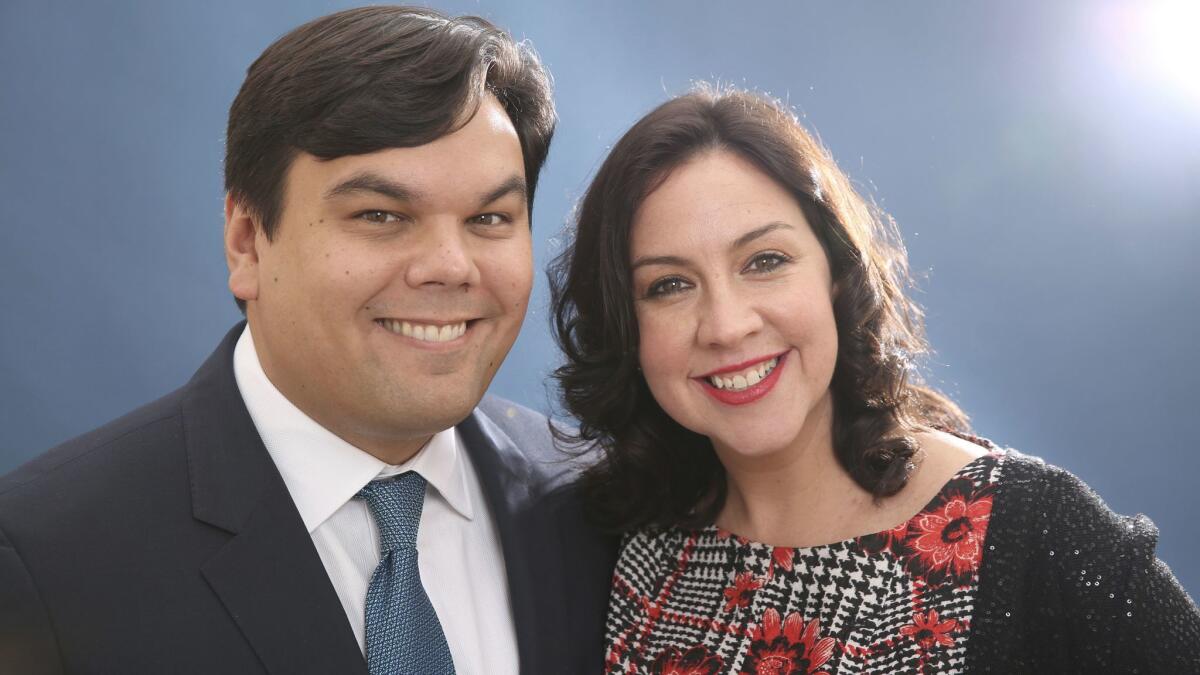Latino artists and cultural leaders weigh in on how ‘Coco’ got it right
- Share via
For Latinos, “Coco” is not just a visually resplendent animated film with a poignant story about the importance of family. It’s also a rallying cry.
“I am certain that Disney/Pixar did not set out to make this a political film, but that is exactly what they have done,” said Benjamin Bratt, who provides the voice of Ernesto de la Cruz, the musical star idolized by the film’s central character, 12-year-old Miguel. “‘Coco’ inspires love around the world, and for Latinos in particular. It’s a reminder that we are worthy of loving ourselves. And if this ain’t a revolutionary act, I don’t know what is.”
The movie is not only a box office hit — amassing $731 million worldwide — and an almost certain Oscar winner — but it’s also been a timely and soothing tonic for a community that has felt attacked and disrespected, particularly by President Trump’s rhetoric and eagerness to erect a border wall between the U.S. and Mexico.
“Where our country might be wanting to put up a wall, Pixar built a beautiful marigold bridge,” said Kristen Anderson-Lopez, who wrote the movie’s Oscar-nominated song “Remember Me” with her husband, Robert Lopez. (The film, which is centered on the Mexican tradition of the Day of the Dead, features a bridge between the land of the living and the land of the dead decorated with marigold petals.)

“Coco,” which opened Nov. 22 and is also nominated for an Oscar for animated feature — could not have come at a more opportune moment.
“The timing is healing, given the open hostility toward our people by the current administration,” said Bratt, whose mother is Peruvian. “The thing I am most proud of is that Latinos instantly developed a proprietary relationship with the film. They have claimed it as their own, visiting it in theaters on multiple occasions, like they would a close family member.”
One of those visitors is writer Carlos Aguilar, who has seen it three times, twice in English and once in Spanish.
“My family back in Mexico City was shocked and moved by how truthfully the film captured traditions and Mexican idiosyncrasies,” he said. “They couldn’t believe that an American studio had made the film, as it felt like an authentically Mexican work of art.”
Aguilar was born in Mexico and has spent most of his life in the U.S.
“The film came out just a couple months after Trump had dismantled DACA [the Deferred Action for Childhood Arrivals immigration policy], at a moment in which we’re being attacked and called lazy and our identities are portrayed in a negative light by the president and other people,” said Aguilar. “To have a film that bridges that cultural gap is very important.”
Since Aguilar cannot return to Mexico because of his immigration status, the film resonated all the more powerfully.
“For many of us Dreamers who haven’t been back to Mexico, we have this memory of a place we used to know,” he said of Dreamers, immigrants who as children were brought to the U.S. without visas. “You can lose that along the way living in the U.S.”
Retired schoolteacher Andrea Pulido is of Mexican descent and taught in Lincoln Heights and Oxnard. She felt proud to see the portrayal of loving, hard-working Mexican families, as did her relatives spanning several generations in Michoacan.
“The timing was very important not only to make Mexican immigrants and Mexican Americans feel empowered and proud at a time when they were being knocked down, but for other people to see them in a more positive, human way,” Pulido said.
Who would have thought that a Disney movie about a boy who loves to play guitar could provide the hope and cultural pride to make a swath of beleaguered Americans feel whole again?
“It’s unbelievable what this film has meant to so many Mexican Americans,” said Alanna Ubach, who voiced the character of Mamá Imelda, Miguel’s great-great grandmother. “I truly feel that we really have been pushed aside. Our heritage has been just so challenged these past couple of years. People forget what a rich, sophisticated culture the Mexican culture is. It’s not just about tacos and sugar skulls.“
In “Coco,” the endearing Miguel Rivera (voiced by Anthony Gonzalez) has a large, loving family, and is particularly close to his great-grandmother Mamá Coco. They run a shoemaking business, a matriarchal enterprise, begun by Coco’s mother, Mamá Imelda, after Coco’s father left with his guitar and never returned.
Because of his abandonment, the family has banned music from its home for generations. Rather than spoil the emotionally resonant story for the few who have not yet seen it, let’s simply say that music and the Mexican tradition of Día de Muertos (Day of the Dead) are equally important to the plot.
Gael García Bernal, who plays Héctor, one of the lead characters who joins forces with Miguel in re-connecting with departed family, believes people should take the ethnic pride the film engenders and act on it.
“If I could dedicate this film to someone, it would be to those kids growing up in the United States who are first-, second- and third-generation Latin American that are just starting to vote,“ García Bernal said. “They come from a very complex culture that is far more sophisticated than the picture that is being drawn by those in power. Let’s not minimize it. Let’s not let it pass. Let’s not have this be like a little gesture.”
Such fervent, politically charged comments strike a familiar chord with the filmmakers.
“We all feel incredibly humbled and grateful to be a part of putting something into the world that has had as much an effect on an entire community as ‘Coco’ has,” said director Lee Unkrich.
The filmmakers at Pixar are proud that their picture has drawn such impassioned reactions both with Latinos and in Mexico, where it is the top-grossing movie of all time.
Adrian Molina came on board as a story artist at the project’s inception in 2011, joining forces with Unkrich and producer Darla Anderson. He became co-writer and co-director a couple years later.
“We’ve had some very rough times in the world between then and now,” Molina said. ”We knew we were putting something good out into the world, and I felt the world needed it more and more. When we were able to release it in theaters, it was kind of a salve for the soul for Mexicans to see themselves and the things they love about themselves and their families.”
The movie has been embraced globally, with it translated into about 40 languages. But it was the appreciation and affection received in Mexico, where it opened first, that spoke volumes to Unkrich, Molina and Anderson.
“It was very important to the team that it be a true representation of a Mexican family,” Molina said. “I wanted the characters to reflect the diversity of the people I knew growing up and the people we met in Mexico.”
The story underwent a few incarnations, but the filmmakers’ goal was to ensure that Mexicans and Mexican Americans felt that their cultural traditions were respected.
“From the beginning, all we ever wanted to do was make this love letter to Mexico and do it right,” Unkrich said. “I didn’t want any moments where anyone from the Latino culture would cringe.”
Cringe they did not, but cry they often did.
“Both U.S. Latinos and those back in our home countries, were incredibly moved by the relationship between Miguel and his great-grandmother Coco,” said Aguilar. “I don’t know a single Mexican who did not cry profusely during the final sequence when Miguel sings ‘Remember Me’ for her.”
The Mexican-born Jaime Camil, who voices Miguel’s father, was deeply moved when he saw the finished film: “After watching the movie, I was in tears.”
Latin American culture is far too rarely depicted accurately in movies, said Aguilar.
“As a Mexican person, whenever I see content created in Hollywood that’s supposed to represent Mexico, I’m always wary,” he said. “So much of the vision is filtered through clichés and stereotypes. For once, Mexico was not presented as a drug-ridden land or a place for wild partying, but a culturally rich country with plenty of things to be proud of.”
While they knew Pixar was detailed in its research, many of the actors said they had no idea just how meticulous, especially in terms of cultural accuracy.
“To be honest, in the beginning, when I was approached for the part, I was quite curious and with a little bit of concern in terms of where they were going to take it and how it was going to be,” García Bernal said. “Día de los Muertos is maybe the most meaningful celebration we have. It’s very spiritual.”
For Marcela Davison Aviles, Pixar’s lead cultural consultant, the experience was more than affirming. It signaled change.
“
“It validated the notion that I’m increasingly believing in more and more: When change happens for the better, it’s because something happens in the zeitgeist that pushes popular culture and contemporary attitudes to a place of empathy and greater acceptance.”
Not only does “Coco” provide much-needed cultural validation, Aviles said, but it could also help minimize, or even erase, prejudices, much the same way positive depictions of the LGBT community have changed attitudes on a widespread basis: “I think storytelling with regard to issues of race and ethnic groups and communities of color and equity is going to get us to a place where, unfortunately, policy hasn’t been able to go.”
More to Read
Only good movies
Get the Indie Focus newsletter, Mark Olsen's weekly guide to the world of cinema.
You may occasionally receive promotional content from the Los Angeles Times.









